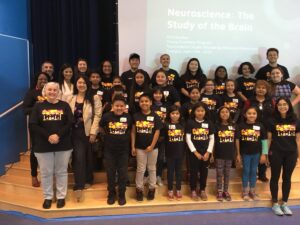 Neuroscience Studio
Neuroscience Studio
Originally Published May 2, 2018
“Have you ever seen a real brain before?”, I asked the crowd of fourth and fifth-grade students gathered in the auditorium at Norwood Elementary School. Many of them shook their heads while making faces of visible disgust at the thought of seeing a brain in the flesh. “What if I told you that you were going to have the chance to see one today?” The shift from apprehension to sheer excitement occurred in seconds, and from that point onward, the students were eager to begin the activities for our workshop.
We had the amazing opportunity to host an educational, after-school workshop at Norwood Elementary School on April 17, 2018, centered around the vast and interdisciplinary field of Neuroscience, a field which focuses on studying the structure and function of the brain and nervous system. While I am admittedly biased in this area of study, I recognize that informing a young generation of scientists and future professionals in the importance of neuroscience is an unquestionably critical action and one that will promote knowledge, awareness and even further research into ways to keep our brains healthy for years to come.
The students participated in four different stations, each of which included several hands-on activities, that sought to engage them directly in practical questions related to Neuroscience, with the ultimate goal of inspiring them to potentially pursue this or another related field of study in their academic careers.
Below is a summary of the activities included at each station:
- Station #1– Sheep Brain Dissection: Students observed as YSP Teaching Staff, as well as undergraduate and graduate volunteers, conducted a sheep brain dissection. Students had the opportunity to interact with (touch) the sheep brain and follow along with the dissection on a Play-Doh brain mold.
- Station #2– Make Your Own Neuron Craft: Students used arts and crafts supplies to create their own model neuron, and in the process learned about the different parts of a neuron, the fundamental unit that makes up all brain tissue.
- Station #3– Sensory Systems: Students learned about how their senses of taste and touch are generated by relaying information from the periphery (hands and tongue) to the brain via nerves. They participated in a game that involved using only their sense of touch to determine what objects they were holding, and they also tried Miracle Berries to temporarily alter their sense of sour taste.
- Station #4– MRI Scanner: Students learned about how researchers and clinicians are able to capture images of a living brain using Magnetic Resonance Imaging, or MRI, and they also looked at real MRI images and made observations about what they saw.